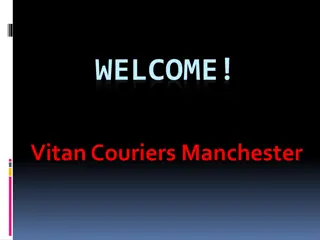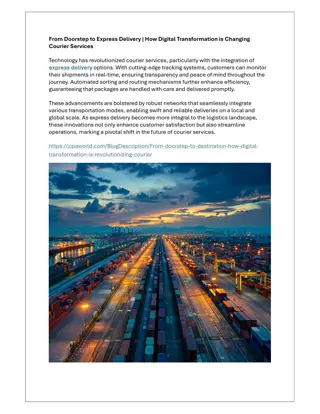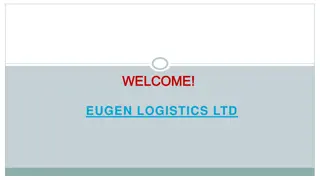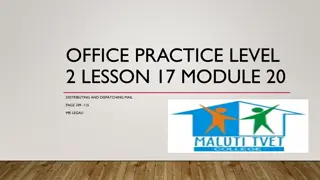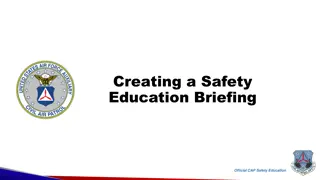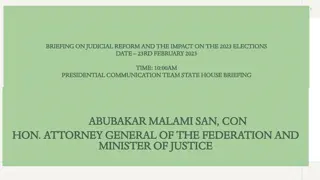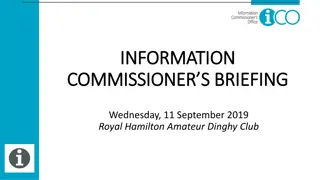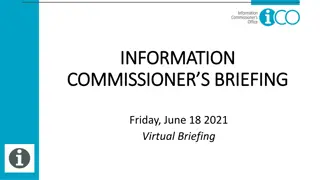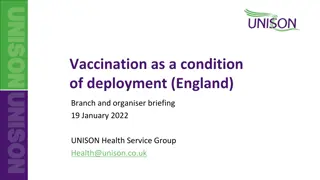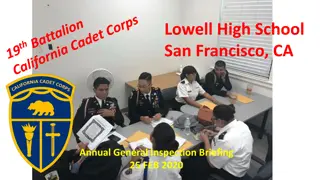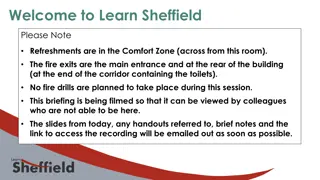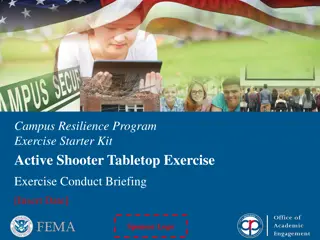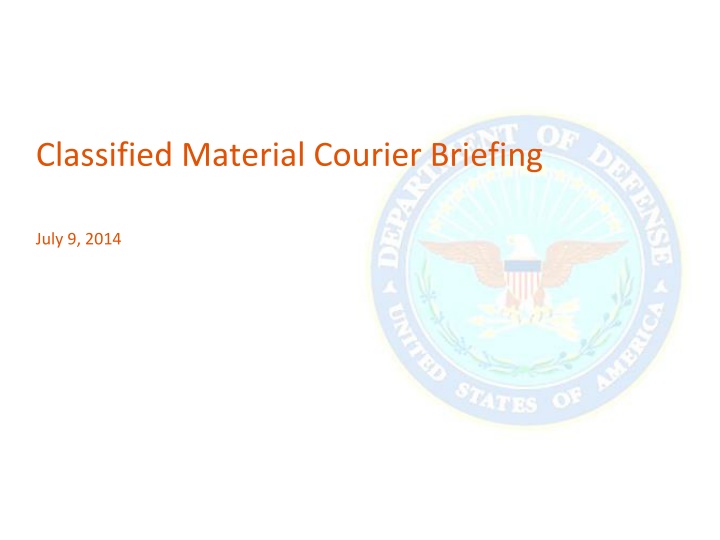
Classified Material Courier Briefing and Responsibilities
Explore the importance of using a classified material courier for transporting sensitive materials between company facilities, government customer locations, and industry partner facilities. Learn about the roles of designated couriers, hand-carriers, and escorts, as well as pre-trip considerations for securely transporting classified material.
Download Presentation

Please find below an Image/Link to download the presentation.
The content on the website is provided AS IS for your information and personal use only. It may not be sold, licensed, or shared on other websites without obtaining consent from the author. If you encounter any issues during the download, it is possible that the publisher has removed the file from their server.
You are allowed to download the files provided on this website for personal or commercial use, subject to the condition that they are used lawfully. All files are the property of their respective owners.
The content on the website is provided AS IS for your information and personal use only. It may not be sold, licensed, or shared on other websites without obtaining consent from the author.
E N D
Presentation Transcript
Classified Material Courier Briefing July 9, 2014
Introduction Why use a Classified Material Courier? Mission requirements, sensitive materials, and time constraints sometimes make the use of a classified courier the preferred method for transporting sensitive materials either between our company facility locations locally or to other government customer facilities and/or industry partner facilities over long distances. Couriering classified material by hand poses special risks. To mitigate these risks, the National Industrial Security Program Operating Manual (NISPOM) and other associated customer-specific documents specify certain requirements and procedures that must be followed. One such requirement is a training briefing to inform classified material couriers of their of their responsibilities and obligations in performing their duties. 2
Introduction Definitions Designated Courier An individual who has been properly briefed and authorized in writing to transport classified material between contractor to government or contractor to contractor facilities and is cleared and authorized access for the material being transported. Hand-carrier An individual who has been authorized to transport classified material in a local geographic area and is cleared and authorized access for the material being transported. Escort An individual who is responsible for maintaining positive control of sensitive classified material in transit but is not cleared for the information nor permitted access to it. 3
Pre Trip Considerations Think about the following: The requirements and procedures for couriering, hand-carrying and escorting classified material do not start when the individual leaves the building or when a shipment leaves the loading dock. The next few slides will review some of the more common pre-trip considerations. 4
Pre Trip Considerations The material must be properly prepared for shipment Couriered material must be inventoried, wrapped and marked in a very specific manner which, in most cases, MUST be done by your security officer. The reason for this is that it must be done according to very specific Department of Defense guidelines as described in the Defense Security Service s Packaging Classified Documents video. 5
Pre Trip Considerations The material must be properly prepared for shipment In some cases, material may not need to actually be wrapped but instead may be placed within a set of two locking briefcases. 6
Pre Trip Considerations Ensure travel documents are in order Before leaving a secure facility with classified materials, couriers, hand- carriers and escorts should ensure their personal travel documents are in order and that they are complete, valid and current. Documents may include: > Passport or other form of government picture identification > Tickets, travel itinerary, reservation confirmation numbers, etc. > Courier authorization badge or letter 7
Pre Trip Considerations Ensure travel documents are in order Your Facility Security Officer may issue you either a courier badge (usually for frequent local missions) or a courier authorization letter. Government regulations require the courier authorization letter to contain the following information: > Name of the company > Full name and description of the courier > Type and description of the ID the individual will present > Description of the material being carried > Point of departure, destination and known transfer points > Effective dates of authorization > Name, title and signature of official authorizing the mission > Name, title and phone number of government agency authorizing the mission 8
Pre Trip Considerations Carry proper identification In addition to carrying a form of government picture identification such as a driver s license or passport, the NISPOM requires that all couriers have an identification card or badge that includes the contractor s name, the employee s name, and a photograph of the employee. Your Company ID badge meets this requirement. Insert a generic copy of your company ID badge here Defense Division 9
Pre Trip Considerations Prepare for contingencies Circumstances may occur which could jeopardize your ability to ensure proper protection of the material you are carrying. Inclement weather, airport delays, detours, and equipment malfunctions are all things that could hinder your mission so plan ahead and be prepared. 10
Pre Trip Considerations Prepare for contingencies Prepare your route Know where you are going and how to get there. Research your route and print out a map if you are unfamiliar with your destination. For regularly scheduled local courier runs, you should follow a pre-identified route so that if something happens someone can re-trace your steps to find you. Stay in contact If something unforeseen happens during your trip, have a means of contacting emergency assistance and/or someone back at the office to keep them informed or to request assistance or guidance. 11
Pre Trip Considerations Prepare for contingencies Bring enough personnel In some cases, large shipments may require multiple escorts to ensure the material is properly protected while in transit. 12
En Route Considerations Think about the following: Once all your pre-trip actions have been completed and all possible contingencies considered and mitigated you are ready to depart. The following slides will provide some advice and guidance on how to handle the material while you are en route to your destination. 13
En Route Considerations Prevent disclosure and loss at all costs Government regulations require that all couriers retain the classified material for which they are responsible in their personal possession at all times and prevent its disclosure to unauthorized persons. > Vehicles > Public restrooms 14
En Route Considerations Using a public restroom When nature calls Use a stall next to a hard exterior wall and set the material on the floor next to that wall. 15
En Route Considerations When transporting in a vehicle Keep the material in the passenger compartment with you (size permitting) vice storing it in the trunk. DO NOT deviate from the schedule or planned route > Make no unauthorized or unnecessary stops on the way to your destination > You may not stop for a meal during a local courier run You may stop for a meal on a long distance courier trip; however, you must keep the material with you at all times. 16
Arrival Considerations Turnover of material Upon arrival at the destination location, the material must be turned over only to the pre-determined and properly identified recipient. The material should only be turned over if the recipient has an appropriately secure facility and an approved security container in which to store the material. Be sure to obtain a receipt for the package if the material will remain at the destination. 17
Conclusion Questions? This concludes your Classified Material Courier Briefing. Please refer any questions you may have to your Facility Security Officer. 18







